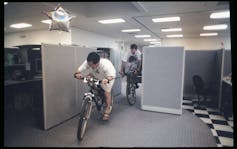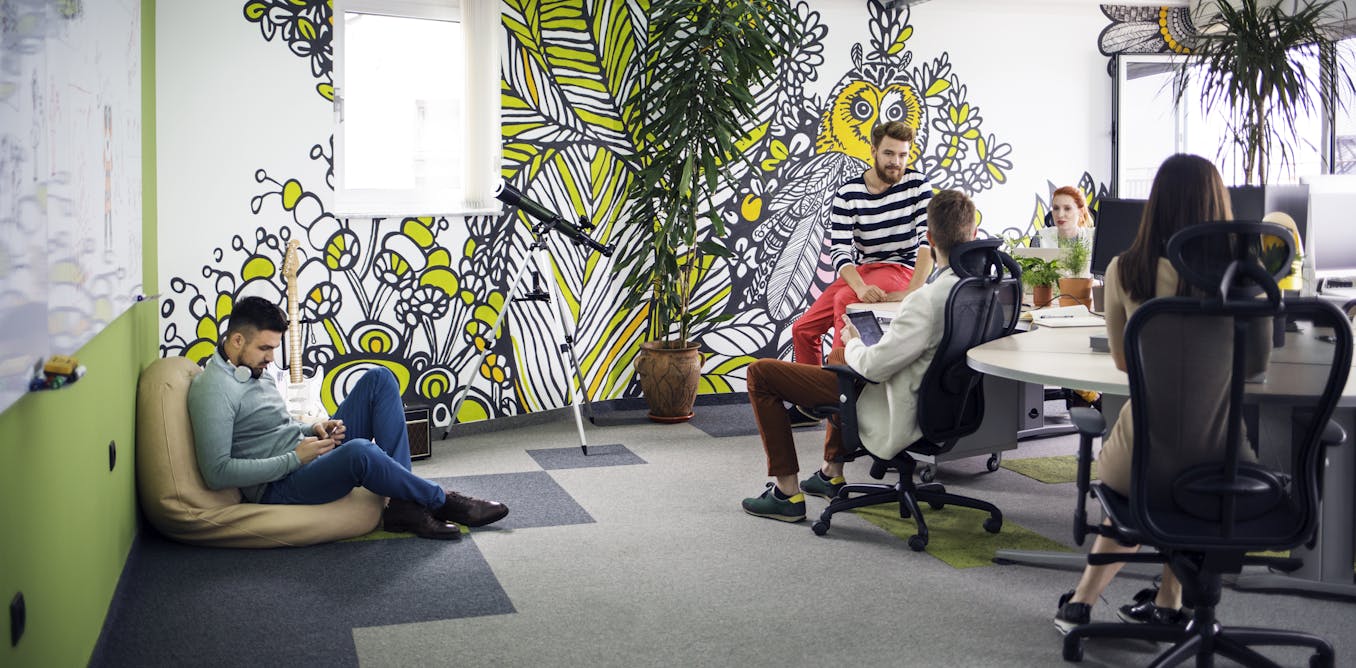It’s been 5 years because the pandemic lockdowns of 2020 disrupted the standard workplace office. For some time, it appeared COVID-19 killed the workplace.
Corporations are actually returning to the workplace in ever higher numbers. As professors who’ve researched distant work and collaboration for many years, we’ve got our counterarguments. However there are classes to be discovered from what we’re calling an “office-forward” method, the place corporations are encouraging workers to work from the workplace more often than not.
Again to (discipline) work
We studied an office-forward firm headquartered within the Midwest with a number of satellite tv for pc workplaces throughout the U.S. earlier than the pandemic, throughout lockdown, and because it navigated the return-to-office panorama. We embedded ourselves throughout the firm for simply over two years and carried out discipline observations, focus teams and one-on-one interviews with a complete of 56 workers. We have been struck by how workers talked about their administrative center:
“That is my place. I really feel very taken care of right here.”
“Each time I are available in, I really feel welcomed.”
“It’s such a welcoming place to come back again to work each day.”
These feedback communicate to the optimistic tradition of this firm. However additionally they trace at one thing actually attention-grabbing: Staff may even see the workplace house as a welcoming place to be.
That is vital as a result of analysis throughout disciplines — from anthropology to organizational science — has proven that individuals develop attachment to locations, not areas. Take into consideration a home versus a house. A home is a construction; a house is a spot of neighborhood.
And so, whereas the workplace isn’t a house, we discovered that an office-forward technique might be profitable if employers rework their workspaces into workplaces, or into locations of neighborhood. Listed here are three transformation techniques we found:
1. Present house for place
Can the workplace help neighborhood? Can the workspace be a office?
Our analysis exhibits that workers see the workplace as a optimistic place when it meets their wants. The extra targets individuals can accomplish in an area, the extra connected they really feel to it. As one worker informed us: “If you wish to work independently, there’s an area for that. If you wish to collaborate with others, there are areas for that. If you wish to eat lunch with 50 individuals, you are able to do that. Or, in the event you simply need to have, like, a one-on-one, you are able to do that as properly. There may be flexibility, simply relying upon your temper, and perhaps what you might want to accomplish that day.”
We predict this exhibits the worth of redesigning “areas” as “locations” that meet a number of work-related and human wants.
We additionally documented the significance of offering a workstation for each worker. It’s easy: People are territorial. When you can’t put an image of your loved ones in your desk, you are feeling stripped of your humanity. An worker shared: “I do know numerous corporations make you bounce round. Sounds horrible to me. Right here, I’ve my little cubicle, and I like that.”
To not point out the massive inconvenience of getting to truck your stuff — even your mug and your mouse — to and from the workplace each day. Desk-sharing is antithetical to put attachment as a result of it treats individuals like cogs.
2. Move the place-making baton to employees
Individuals are those who flip areas into locations. To perform this, some crucial mass of individuals should use the bodily infrastructure collectively.
The corporate we studied imagined its workplace as a social — not only a work — enviornment. It dreamed up all kinds of engagement alternatives. It hosted breakfasts and lunches, had film nights, invited meals vehicles and ice cream vans, threw silent dance events, and extra.
Staff informed us they loved each “the casual, natural interactions once I go right down to get espresso within the morning” and the “vitality I really feel when there are occasions within the workplace.” Infusing social alternatives of all sizes and styles into the workplace means individuals are making reminiscences within the workplace collectively. And this implies they’re constructing neighborhood.

Meri Simon/MediaNews Group/The Mercury Information through Getty Photos
However this firm went additional. It handed the place-making baton. Staff may personalize the house. One group put in a mini-golf course; one other painted a mural on an workplace wall within the heart of the constructing. Staff used the house how and after they needed to. Some did strolling conferences on the treadmills; others performed video video games after lunch.
Most significantly, workers hosted their very own actions within the workplace. We don’t simply imply child showers and such; we imply inviting the board of a nonprofit for a gathering on the workplace or inviting a gaggle of scholars for an workplace tour. Turning space-users into place-makers means individuals develop a way of shared possession of the space-turned-place. No marvel we saved on listening to possessive language: “There’s numerous delight in the truth that that is our place” and “This can be a constructing of the individuals, to place it in a slogan-y approach.” The workplace had develop into a spot of neighborhood.
3. Use expertise to create neighborhood
Expertise is an integral a part of the post-pandemic office. With elevated flexibility, workers aren’t within the workplace on a regular basis, even in corporations with in-person insurance policies. Since 2022 a variety of corporations – some current examples embody Amazon, AT&T, Tesla and others – have applied strict in-person necessities, suggesting that expertise is disruptive to workplace neighborhood. However expertise generally is a place-maker. It might nearly prolong the sense of neighborhood from the corporate workplace to the house workplace.
The corporate we studied ensured that workers continued to really feel a connection to the workplace when working from house throughout the pandemic. Executives created movies, human sources employees created newsletters and mailed firm swag and treats to workers’ houses, and group leaders hosted digital occasions and video games to maintain everybody related.
Even after the pandemic, the corporate constructed Zoom rooms conducive to hybrid group conferences the place all workers may really feel current. It created branded digital backgrounds and added branding to their digital assembly rooms and software program programs to remind of the workplace. It even employed an intern to publish updates on firm happenings on the corporate’s social media channels. The outcome? We heard this: “I really feel welcome on this digital workplace, too!”
The prize of all of it
Place-making works, however it doesn’t work for everybody. In our analysis, most workers have been what we name “place-attached” earlier than the pandemic. However after the pandemic, some had misplaced their sense of connection to the workplace and the sense of neighborhood they used to really feel there. These place-detached workers felt “I’m simply there to be there” and “The touchy-feely isn’t the place I get my worth from.” We estimate that about 30% of the post-pandemic workforce at this firm now feels disconnected from the corporate tradition and the emphasis on being within the workplace for work.
However contemplating how many individuals found throughout the pandemic that they like to work at home, 30% is definitely fairly a low quantity.
The shock – for us, at the least – was that about 70% of workers within the firm we studied remained connected to their workplace house in 2025. In different phrases, 7 in 10 proceed to search out neighborhood within the workplace. Our analysis unpacks this summary idea additional: What does “discovering neighborhood” imply? What outcomes does it translate into?
The reply is that place-attached workers expertise intrinsic satisfaction from workplace work. “It’s like going to the gymnasium,” one worker informed us. “It’s onerous to go, however the vitality right here is a lot greater.”
They really feel extra embedded within the firm’s social material: “Grabbing a cup of espresso, simply speaking to your colleagues, makes you are feeling related.”
They really feel extra productive: “I feed off different individuals’s vitality within the workplace.”
They really feel seen: “We work onerous, however we have fun one another right here.”
And the large one — they derive a way of meaningfulness and function: “Entering into work, it’s like somebody wants me, I’ve a spot to go, a spot of function.”
And so, opposite to our personal preconceived notions as distant work researchers about the advantages of distant work, we discovered that office-forward workplaces should be part of the post-pandemic office combine. Whereas some workers worth work at home, others worth working from the workplace. What we hope employers be taught from our analysis is that for an office-forward method to work, workspaces should rework into workplaces, or into locations of neighborhood.
